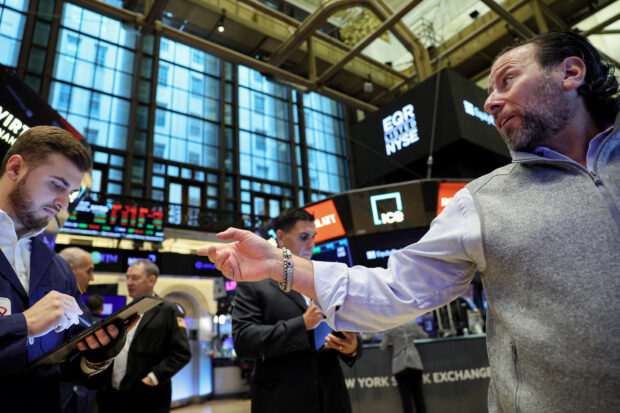Global stock index dips while bond yields, dollar climb

Traders work on the floor of the New York Stock Exchange (NYSE) in New York City, U.S., Sept 28, 2023. REUTERS/Brendan McDermid/File photo
NEW YORK – MSCI’s global index of stocks kicked off fourth-quarter trading with a decline as U.S. Treasury yields and the dollar rose while investors worried that rates would stay higher for longer.
While a short-term spending deal averted a partial U.S. government shutdown, the news failed to raise much enthusiasm among investors as it provides funding for less than two months.
U.S. stocks were a mixed bag while earlier in Europe stocks closed down after September PMI data, a key economic indicator, showed manufacturing activity still in a downturn. But U.S. manufacturing took a step further toward recovery in September as production picked up and employment rebounded.
While U.S. Federal Reserve Vice Chair for Supervision Michael Barr said he feels the Fed’s policy rate is “at or near” a sufficiently restrictive level to bring inflation down, he also said that rates will need to stay high for some time.
READ: ‘Higher for longer’ interest rates remain a threat to US stocks
Meanwhile, Fed Chair Jerome Powell reiterated the central bank’s emphasis on controlling inflation, saying price stability is needed to foster a sustained, strong labor market.
“The sell-off in bonds has been continuing. There’s a combination of economic growth being higher-than-expected and the Fed having to keep rates higher for longer and general concern that the United states is not keeping its fiscal house in order,” Chris Zaccarelli, chief investment officer at Independent Advisor Alliance in Charlotte.
US Treasury notes, dollar index
The 11th-hour U.S. government funding bill will mean that key data releases including Friday’s monthly payrolls report can go ahead on time. Delayed data could have intensified market uncertainties by keeping the Fed on the sidelines.
“The fact we averted a shutdown should be a positive but to be fair they only kicked the can down the road. The good news is only lukewarm good news,” Zaccarelli said.
The Dow Jones Industrial Average fell 74.15 points, or 0.22 percent, to 33,433.35, the S&P 500 gained 0.34 points, or 0.01 percent, to 4,288.39 and the Nasdaq Composite added 88.45 points, or 0.67 percent, to 13,307.77.
The pan-European STOXX 600 index earlier closed down 1.03 percent while MSCI’s gauge of stocks across the globe shed 0.51 percent.
In U.S. Treasuries, benchmark 10-year notes hit their highest yield since 2007 and were last up 12 basis points to 4.691 percent, from 4.571 percent late on Friday. The 30-year bond was last up 9.3 basis points to yield 4.8021 percent, from 4.709 percent. The 2-year note was last was up 7.1 basis points to yield 5.1166 percent, from 5.046 percent.
In currencies, the dollar climbed, building on four straight weeks of gains after the stop-gap funding bill was passed and after economic data that supported the view the U.S. Fed will have to keep rates higher for longer.
READ: Dollar sticks near 10-month high, keeping heat on yen
“It’s the feeling that the U.S. economy can stomach higher interest rates for a little bit longer,” said Bipan Rai, North America head of FX strategy at CIBC Capital Markets in Toronto.
The dollar index, which measures the greenback against a basket of major currencies, rose 0.696 percent, with the euro down 0.84 percent to $1.0481.
The Japanese yen weakened 0.33 percent versus the greenback at 149.83 per dollar, while Sterling was last trading at $1.2089, down 0.89 percent on the day.
Japan’s Finance Minister Shunichi Suzuki said authorities were closely watching FX moves with a “strong sense of urgency” as it neared the 150 mark, at which intervention is expected. But the minister declined to comment on whether intervention was a possibility at this point.
Crude prices, gold
U.S. crude oil prices fell 2 percent on Monday to a three-week low as a higher-priced Brent contract expired, the U.S. dollar strengthened and traders took profits, concerned about forecasts of rising crude supplies and pressure on demand from high interest rates.
U.S. crude settled down 2.17 percent at $88.82 per barrel and Brent ended at $90.71, down 1.62 percent on the day.
Gold was on track for its sixth consecutive loss, hitting a near seven-month low as a robust dollar and prospects of higher U.S. interest rates took the shine off bullion.
Spot gold dropped 1.1 percent to $1,828.99 an ounce. U.S. gold futures fell 1.03 percent to $1,829.00 an ounce.